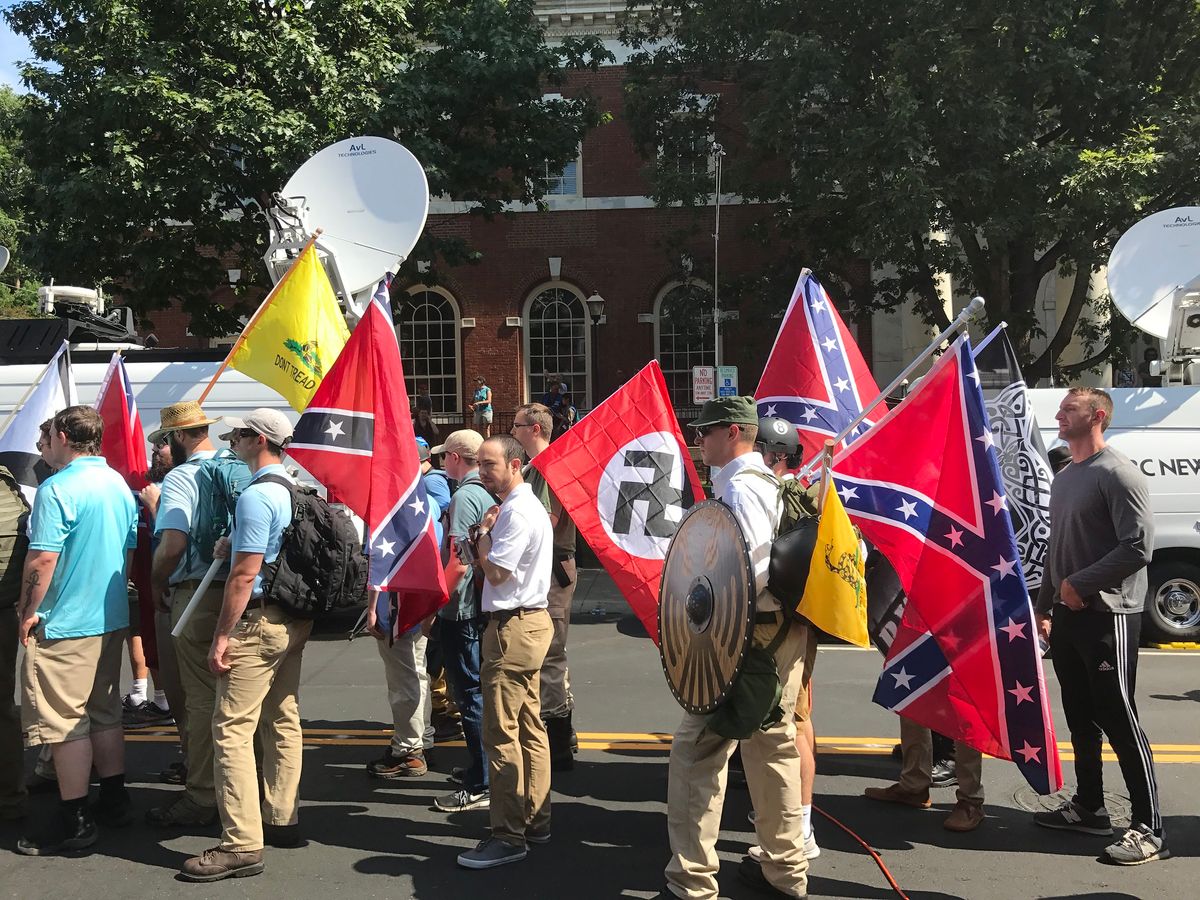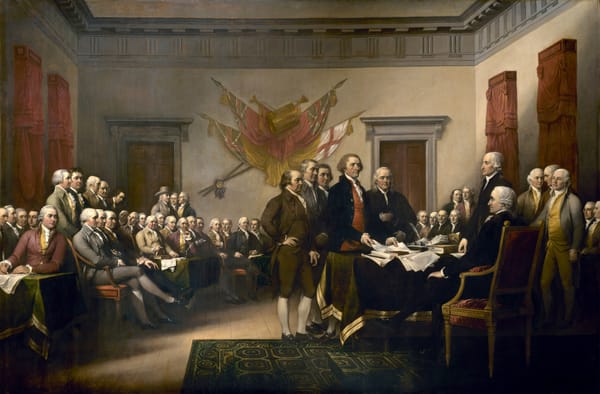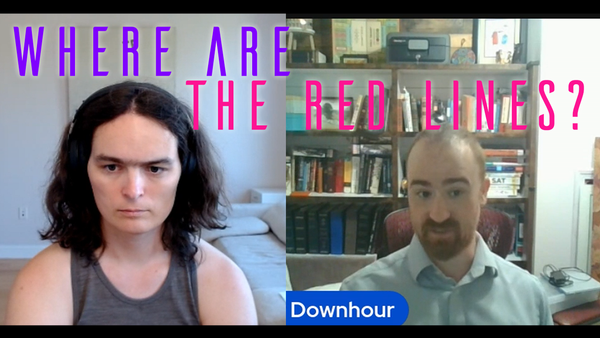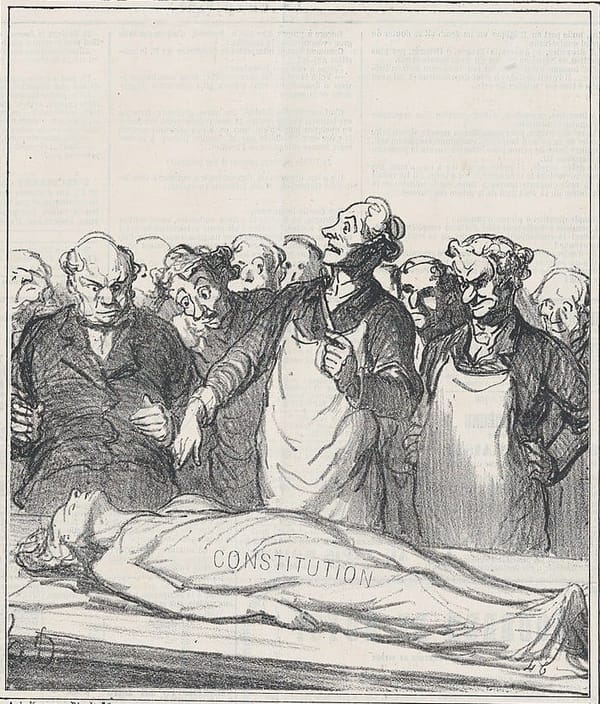Is Trump's Anti-Semitism Deliberate? A Reappraisal

Whenever I set aside time to write about anti-Semitism in contemporary politics, I block out some time to make substantive updates for the inevitable anti-Semitic scandal(s) that will happen in between my first draft and the potential publication. In the contemporary environment, the probability of a major political figure saying or posting something arguably anti-Semitic in any given week is slowly approaching one.
This time, we had the news that the Trump campaign was using advertising with the red triangle to criticize certain left wing protesters. An identical red inverted triangle was the Nazi symbol used to designate political prisoners in concentration camps. The Trump War Room insists they used the symbol because it appears in anti-fascist graphics, which it does not.
The red triangle advertisements opened up a question of whether the Trump campaign was merely ignorant, as they claim. While I find his criticism too mild, Anti-Defamation League CEO Jonathan Greenblatt argued that “ignorance is no excuse.” That piece was written following Trump’s remarks on Henry Ford’s “good bloodlines,” but it focused on the long-running discussion over whether the use of racist and anti-Semitic dog whistles in the Trump campaign is intentional or not.
Add on the controversy surrounding various Trump campaign images of an eagle similar to the Third Reich’s, which has been adopted globally by neo-Nazi groups. There is some dispute over whether it looks like the Nazi adaptation of the Reichsadler or a variation on the American icon that appears in various United States seals.
There are a handful of possible positions one might take on the presence of these dog whistles. Among them are: The dog whistles are intentional and therefore blameworthy; or the dog whistles are unintentional, but still blameworthy—the position adopted by Greenblatt. This post explores my own shift in appraisal, from the latter to the former.
Hanlon’s razor
One of my most closely guarded commitments, in politics, philosophy, and life, is Hanlon’s Razor.
Never attribute to malice that which can be adequately explained by stupidity (or incompetence, or obliviousness).
Hanlon’s Razor is the morally and politically appropriate attitude under most circumstances. People screw things up; people make mistakes. By acknowledging that these are mistakes of some variety, rather than malicious and deliberate, we can try to interact in good faith with people we might otherwise regard as evil, sparing ourselves the painful general worldview that most people are malicious monsters. We get to substitute moral cynicism with the rosier cynicism that people screw up a lot. In many cases, errors may still be blameworthy; gross negligence may be the result of incompetence but still incur moral—or even legal—responsibility. Still, the outlook on the human condition is markedly less bleak.
There is a further moral argument for Hanlon’s Razor. We have an obligation to each other to regard errors as screw ups, to admit of apology and reconciliation where possible. The liberal agreement is to broadly tolerate a diverse range of views and behaviors, but also to hold a second-order attitude of tolerability towards cases on the border of what is tolerable.
I will not flesh out the particular merits or limits of Hanlon’s Razor in detail here. Hanlon’s razor has limits. Things like slavery and rape and genocide are not “adequately explained by ignorance or incompetence.” As such, those don’t fall under the scope of Hanlon’s Razor.
A charitable beginning
My initial inclination towards Trump’s various borderline anti-Semitic claims was to get out Hanlon’s Razor. His remarks to the Republican Jewish Coalition could have been a reference to the Jewish Republicans in the audience rather than about Jews in particular. His remarks on Charlottesville could have been an attempt to defend his base, with some malicious input from advisers who clearly wanted to dog whistle to the khaki-shorts-wearing cockwombles chanting “Jews will not replace us” marching to preserve a statue of a Confederate figurehead.
Applying Hanlon’s Razor in such cases does not offer moral absolution. Politicians are responsible for what they say. Double-meanings, whether intentional or not, are frequently taken up by parts of the audience liable to accept interpretations. As such, some politicians will apologize for dog whistles, even with their unintentional invocation. Ilhan Omar’s apology for remarks on hypnotism are illustrative.
The application of Hanlon’s Razor to Trump’s remarks is easy in one respect: Trump is quick to demonstrate that he’s not historically literate, and indeed one wonders at times whether he is literate at all.
I no longer think applying Hanlon’s Razor is defensible; I no longer think the defense of Trump’s long history of anti-Semitic remarks can be either that (a) he doesn’t know what he’s doing or (b) there are figures around him putting that rhetoric in his ear. His media team shows special relish in the use of anti-Semitic dog whistles (as the case of the red triangles illustrates); this will become especially vivid below. At this point, ignorance is not a plausible explanation for Trump’s remarks.
This is not significant for moral reasons. What he was doing has always been wrong. Any competent political leader, much less the head of the government of the United States of America, should know better. Politicians have teams of communications experts around them to help craft a message, even when those politicians are themselves good communicators. In addition, for years folks outside of the White House have pointed out this pattern of remarks, and yet the pattern continues.
Charlottesville
One major incident that sparked many to accuse Trump of anti-Semitism were his comments around Charlottesville.
Folks are often accused of taking Trump’s remarks on the Charlottesville protest —which consisted of marchers chanting “Jews will not replace us” and carrying Nazi flags —out of context. The full context is available here. Below is the relevant section
Reporter: “Mr. President, are you putting what you’re calling the alt-left and white supremacists on the same moral plane?”
Trump: “I’m not putting anybody on a moral plane. What I’m saying is this: You had a group on one side and you had a group on the other, and they came at each other with clubs — and it was vicious and it was horrible. And it was a horrible thing to watch.
“But there is another side. There was a group on this side. You can call them the left — you just called them the left — that came violently attacking the other group. So you can say what you want, but that’s the way it is.
Reporter: (Inaudible) “… both sides, sir. You said there was hatred, there was violence on both sides. Are the — “
Trump: “Yes, I think there’s blame on both sides. If you look at both sides — I think there’s blame on both sides. And I have no doubt about it, and you don’t have any doubt about it either. And if you reported it accurately, you would say.”
Reporter: “The neo-Nazis started this. They showed up in Charlottesville to protest — “
Trump: “Excuse me, excuse me. They didn’t put themselves — and you had some very bad people in that group, but you also had people that were very fine people, on both sides. You had people in that group. Excuse me, excuse me. I saw the same pictures as you did. You had people in that group that were there to protest the taking down of, to them, a very, very important statue and the renaming of a park from Robert E. Lee to another name.”
The context does not salvage the remark, and the core conceit of the remark is profoundly morally repugnant.
To paraphrase an old joke: What do you call the people who show up at a rally and march with the guys carrying the swastikas? Nazis. If you’re participating in the event and people are waving swastikas around (even “ironic” swastikas), that’s bad. At a minimum, you’re contributing to the impression that American neo-Nazis have political support.
Charlottesville was a mix of Nazi flags with confederate flags, of chants not recognizable to some marchers (“Blood and Soil”) with obviously repugnant phrases (“Jews will not replace us”). Dog whistles are effective, in part, because some members of an audience will not recognize them and endorse the message without understanding. There, Hanlon’s Razor applies. The plausibility of ignorance disappears when the swastika is visible, when the references to Jewish conspiracy are explicit. That is exactly what happened in Charlottesville.
What people tend to miss here is the lie at the beginning. “They came at each other with clubs.” There were a handful of criminal charges filed after the event; they indicate that the violence was one-sided.
In the moment, I interpreted this equivocation as an attempt to try and defend a group that Trump knows many of his supporters are sympathetic with, protesting a cause many of his core supporters like (namely, the “preservation” of Confederate statues). Lumping them in with neo-Nazis was, in other words, an error committed while attempting to defend this somewhat more palatable group.
I now think this was a mistake, not because we should condemn confederate monuments, but because the broader context does not indicate that it was a misunderstanding on Trump’s part. It was deliberate.
“America First” in history
Trump’s campaign and political rhetoric has long embraced the slogan “America First.” While not the official slogan for the campaign, it has taken on the role of an outright position on trade and foreign policy in the administration. There’s a problem with “America First.” It has a fairly deep anti-Semitic history.
The genesis of the slogan was the isolationist policy of Woodrow Wilson, a policy that became used to symbolize American opposition to involvement in WWII.
The America First Committee was opposed to United States intervention in WWII, starting prior to Pearl Harbor. It was weakened significantly and the committee itself disbanded following Pearl Harbor (when US involvement became inevitable), but a group under the banner still ran an isolationist political candidate for President in 1944. Was isolationism itself anti-Semitic? Not necessarily, though it plainly condemned millions of Jewish people to death.
But the rhetoric of the America First movement focused on a narrative of Jewish conspiracy, that Jewish leaders in America and abroad were trying to bait the American government into WWII because of the Nazis anti-Semitic posture. These included denialism about killing of Jews as propaganda by this conspiracy, or outright justification of anti-Semitism, citing the anti-Semitic conspiracy theory work of figures like Henry Ford.
Following WWII and greater public awareness of the atrocities of the Holocaust, the phrase was adopted by some neo-Nazi movements in America opposed to American involvement in foreign affairs, the broad non-interventionist ideology coupled with the view that some conspiratorial cabal (generally Jewish or “Zionist” or some euphemism) was behind the American military-industrial complex, a still persistent myth in both far left and right political conspiracy theories.
The phrase briefly gained a new run at popularity with the Presidential campaign of Pat Buchanan, directly appealing to the America First Committee and the WWII era non-interventionists. Unsurprisingly, Buchanan himself adopted an enormous amount of the anti-Semitic conspiracy theory rhetoric, rhetoric that correctly branded Buchanan as a bigot.
Again, perhaps one might cite political ignorance here on Trump’s part, though this is significantly undercut by the observation that one such figure criticizing Buchanan at the time was Trump himself. That critique didn’t include Buchanan’s use of the “America First” branding, but did include the broad bigotry that is now a staple of Trump’s own political brand.
The America First brand has been discussed at length and criticized all over the political spectrum because of its history. While Trump generally has an indifference to and limited understanding of history, the role of this slogan has been widely criticized to the point where its continued use itself constitutes a statement from the campaign.
I want to couple this with an observation about Trump’s political rhetoric, which has also been criticized extensively for anti-Semitic content and euphemisms. The America First example is one that is ubiquitous, but there are others. His use of “globalists” and appeals to various conspiracy theories frequently incurs similar criticisms. Even if the rhetoric is not intentional, a politician occupying the Presidency of the United States should know better and take more care.
The moral tango on these issues goes as follows.
Trump says something that has anti-Semitic interpretations or content outright.
People criticize Trump’s remarks.
His apologists say, “He didn’t mean it like that.”
Critics suggest that he should be more careful with his language.
His apologists say, “That’s just Trump being Trump.”
Lather, rinse, repeat.
Plausible deniability of intended interpretation diminishes over time. If someone uses a euphemism, gets called out on it, and then continues to use the euphemism, that impacts whether the remark can be plausibly interpreted as a mistake. At a certain point, following corrections on these matters, ignorance is no longer a reasonable defense. You can’t plead ignorance after doing the same thing and being called on it a dozen times.
Anti-Semitism in action
Things get darker when we turn to policy and political messaging within the White House. The White House has routinely invited figures widely regarded as inappropriate by Jewish communities to major events. In some cases, the White House pleads that these were failures of vetting or the fault of someone else (as when Pence had a Jews for Jesus preacher at an event commemorating Pittsburgh) and in other cases they just shrug it off (as when they invited Robert Jeffress to the opening of the new embassy to Israel in Jerusalem). Symbolic gestures are telling in these cases not because they’re especially impactful compared to policy, but because the symbolism of the gesture is supposed to be considered and deliberate.
If you stage a photo-op, then you’re expecting people to take photos. What you put in those photos, or allow in those photos, is considered.
Unfortunately, the policy side is far worse. One of the first moves in the White House was decreasing funding to combat white supremacist hate crime. Hiring Sebastian Gorka, who has outright denied the existence of white supremacist terrorism, was an indicator of a serious lack of understanding. Gorka’s wife was also hired, and purportedly played a major role in the DOJ shift in funding away from combatting white supremacist terrorism, despite expert consensus about the danger of white supremacist domestic attacks.
There are internal reports of significant indifference by the administration to increases in white supremacist terrorism throughout the United States. There is documented evidence of enormous spikes in white supremacist hate crimes and anti-Semitic hate crimes in particular, which evidence indicating that the increase in violence largely comes from the political right. The sources of the data on these issues, the exacerbation of the condition of white supremacist terrorism, comes from sources as diverse as the FBI, Anti-Defamation League, and the Southern Poverty Law Center. Even if you have beef with one or two of those sources, the data abounds.
Still, Trump leans on the claims about law and order, about national security, while reducing funding. Why? Because the administration’s priorities, as with America First, represents a commitment not to those principles as such, but to a narrow interpretation of those principles beneficial to a particular group of their constituents. Both White House and GOP Congressional statements and policy priorities have made this obvious at this point. For example, the party has focused on issues with social media content solely through a partisan lens, rather than on the dissemination of white supremacist content; the decision to steer away from such discussions is motivated in part by historical affiliations of white supremacist content posters—like Alex Jones or Prager U—with GOP figures.
Again, these concerns have been brought up to Trump on many occasions, and he has occasionally responded by saying simply he’s the “least anti-Semitic person you’ve ever met.” All of this while continuing on this policy path, after Tree of Life and Chabad of Poway and many other incidents.
Undeniable intent
I revisited the ascription of malice to Donald Trump when he made public remarks praising Henry Ford and the “good bloodlines” of the Ford Motor Company. As the Algemeiner article notes, Trump frequently speaks of “good genes” and other such phrases. I’d like to say that the reasoning was due to an acute and clearly identifiable symptom in the phrase “good bloodlines,” a feature of its history (like America First or “when the looting starts, the shooting starts”). But it’s not. Trump did the same thing with Henry Ford in 2019. It’s chronic.
When someone is repeatedly corrected on a matter, when the same mistakes are repeated over and over and over and over, without any meaningful direction towards tempering future mistakes, the explanation grounded by incompetence or ignorance dissolves. What remains is the possibility (a) that the person doesn’t care enough about the issue to address it or (b) that the person affirmatively likes doing the thing for which they’re being criticized, and is actively deciding to do it. We might call (a) the passive approach and (b) the active approach. But that’s not really important, because on issues like anti-Semitism—or any bigotry where the fomenting directly contributes to violence—the moral difference is soft.
Historically, philosophers distinguish between “killing” (active) and “letting die” (passive) as a subtle difference that might weigh on the moral calculus of some cases. But the consensus view is that cases where preventing harm would be easy, the moral difference dissolves. Letting a child die from drowning (passive) when you could easily save them at no risk to yourself is seriously morally wrong. Is it as morally bad as actively drowning the child? That may be subject to debate. But both are far in the morally damnable end of the spectrum such that the differences absolve no blame.
And that’s where we are with Trump. Whether he is deliberately invoking anti-Semitic conspiracies, or directing legions of Twitter followers towards such theories, is no longer relevant. Even if it is the result of a passive failure to correct his behavior over time, at this point that still requires intent and the adoption of a repugnant moral indifference.
Featured Image is Charlottesville “Unite the Right” Rally, by Anthony Crider




